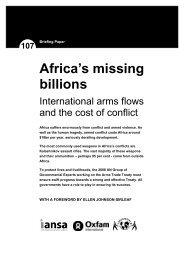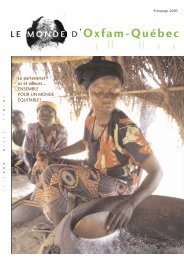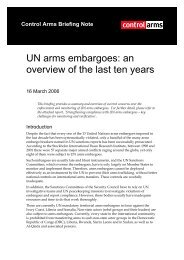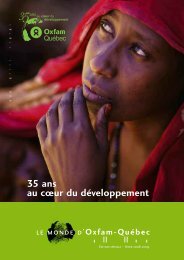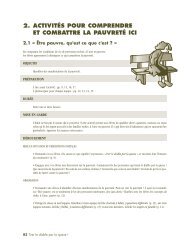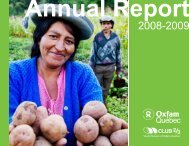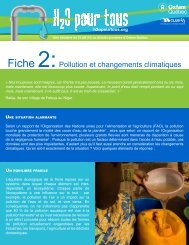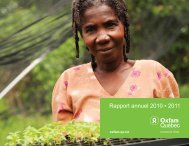- Page 2:
HOW ACTIVE CITIZENS AND EFFECTIVE S
- Page 5 and 6:
First published by Oxfam Internatio
- Page 8 and 9:
LIST OF FIGURESFigure 3.1: Assessin
- Page 10 and 11:
LIST OF ACRONYMSFAOFDIFTAG7G8GATSGA
- Page 12 and 13:
ACKNOWLEDGEMENTSThe word ‘editor
- Page 14 and 15:
FOREWORDGeorge Bernard Shaw argued
- Page 16 and 17:
FOREWORDThis book, which I hope wil
- Page 18 and 19:
PART ONE
- Page 20 and 21:
1 INTRODUCTION THE UNEQUAL WORLDEnd
- Page 22 and 23:
1 INTRODUCTION THE UNEQUAL WORLDExt
- Page 24 and 25:
1 INTRODUCTION THE UNEQUAL WORLDPOV
- Page 26 and 27:
1 INTRODUCTION THE UNEQUAL WORLDSuc
- Page 28 and 29:
1 INTRODUCTION THE UNEQUAL WORLDACT
- Page 30 and 31:
1 INTRODUCTION THE UNEQUAL WORLDpeo
- Page 32 and 33:
1 INTRODUCTION THE UNEQUAL WORLDcom
- Page 34 and 35:
PART TWOThe political roots of deve
- Page 36 and 37:
2 POWER AND POLITICS THE POLITICAL
- Page 38 and 39:
2 POWER AND POLITICS THE POLITICAL
- Page 40 and 41:
I HAVE RIGHTS, THEREFORE I AMThe hi
- Page 42 and 43:
2 POWER AND POLITICS I HAVE RIGHTS,
- Page 44 and 45:
2 POWER AND POLITICS I HAVE RIGHTS,
- Page 46 and 47:
2 POWER AND POLITICS I HAVE RIGHTS,
- Page 48 and 49:
2 POWER AND POLITICS I HAVE RIGHTS,
- Page 50 and 51:
2 POWER AND POLITICS I HAVE RIGHTS,
- Page 52 and 53:
2 POWER AND POLITICS I BELIEVE, THE
- Page 54 and 55:
2 POWER AND POLITICS I BELIEVE, THE
- Page 56 and 57:
2 POWER AND POLITICS I BELIEVE, THE
- Page 58 and 59:
2 POWER AND POLITICS I READ, THEREF
- Page 60 and 61:
2 POWER AND POLITICS I READ, THEREF
- Page 62 and 63:
2 POWER AND POLITICS I READ, THEREF
- Page 64 and 65:
2 POWER AND POLITICS I READ, THEREF
- Page 66 and 67:
2 POWER AND POLITICS I READ, THEREF
- Page 68 and 69:
2 POWER AND POLITICS I READ, THEREF
- Page 70 and 71:
2 POWER AND POLITICS I SURF, THEREF
- Page 72 and 73:
2 POWER AND POLITICS I SURF, THEREF
- Page 74 and 75:
2 POWER AND POLITICS I SURF, THEREF
- Page 76 and 77:
2 POWER AND POLITICS WE ORGANISE, T
- Page 78 and 79:
2 POWER AND POLITICS WE ORGANISE, T
- Page 80 and 81:
2 POWER AND POLITICS WE ORGANISE, T
- Page 82 and 83:
2 POWER AND POLITICS WE ORGANISE, T
- Page 84 and 85:
2 POWER AND POLITICS WE ORGANISE, T
- Page 86 and 87:
2 POWER AND POLITICS WE ORGANISE, T
- Page 88 and 89:
2 POWER AND POLITICS I OWN, THEREFO
- Page 90 and 91:
2 POWER AND POLITICS I OWN, THEREFO
- Page 92 and 93:
2 POWER AND POLITICS I OWN, THEREFO
- Page 94 and 95: 2 POWER AND POLITICS I OWN, THEREFO
- Page 96 and 97: I VOTE, THEREFORE I AMWhether in Fl
- Page 98 and 99: 2 POWER AND POLITICS I VOTE, THEREF
- Page 100 and 101: 2 POWER AND POLITICS I VOTE, THEREF
- Page 102 and 103: 2 POWER AND POLITICS I VOTE, THEREF
- Page 104 and 105: 2 POWER AND POLITICS I STEAL, THERE
- Page 106 and 107: 2 POWER AND POLITICS I STEAL, THERE
- Page 108 and 109: 2 POWER AND POLITICS I RULE, THEREF
- Page 110 and 111: 2 POWER AND POLITICS I RULE, THEREF
- Page 112 and 113: 2 POWER AND POLITICS I RULE, THEREF
- Page 114 and 115: 2 POWER AND POLITICS I RULE, THEREF
- Page 116 and 117: 2 POWER AND POLITICS I RULE, THEREF
- Page 118 and 119: 2 POWER AND POLITICS I RULE, THEREF
- Page 120 and 121: 2 POWER AND POLITICS I RULE, THEREF
- Page 122 and 123: 2 POWER AND POLITICS FROM POVERTY T
- Page 124 and 125: PART THREEAn economics for the twen
- Page 126 and 127: 3 POVERTY AND WEALTH A TWENTY-FIRST
- Page 128 and 129: 3 POVERTY AND WEALTH A TWENTY-FIRST
- Page 130 and 131: 3 POVERTY AND WEALTH A TWENTY-FIRST
- Page 132 and 133: 3 POVERTY AND WEALTH A TWENTY-FIRST
- Page 134 and 135: 3 POVERTY AND WEALTH A TWENTY-FIRST
- Page 136 and 137: LIVING OFF THE LANDThe smoky, cold
- Page 138 and 139: 3 POVERTY AND WEALTH LIVING OFF THE
- Page 140 and 141: 3 POVERTY AND WEALTH LIVING OFF THE
- Page 142 and 143: 3 POVERTY AND WEALTH LIVING OFF THE
- Page 146 and 147: 3 POVERTY AND WEALTH LIVING OFF THE
- Page 148 and 149: 3 POVERTY AND WEALTH LIVING OFF THE
- Page 150 and 151: 3 POVERTY AND WEALTH LIVING OFF THE
- Page 152 and 153: 3 POVERTY AND WEALTH LIVING OFF THE
- Page 154 and 155: 3 POVERTY AND WEALTH LIVING OFF THE
- Page 156 and 157: 3 POVERTY AND WEALTH LIVING OFF THE
- Page 158 and 159: 3 POVERTY AND WEALTH LIVING OFF THE
- Page 160 and 161: 3 POVERTY AND WEALTH LIVING OFF THE
- Page 162 and 163: 3 POVERTY AND WEALTH LIVING OFF THE
- Page 164 and 165: 3 POVERTY AND WEALTH LIVING OFF THE
- Page 166 and 167: 3 POVERTY AND WEALTH THE CHANGING W
- Page 168 and 169: 3 POVERTY AND WEALTH THE CHANGING W
- Page 170 and 171: 3 POVERTY AND WEALTH THE CHANGING W
- Page 172 and 173: 3 POVERTY AND WEALTH THE CHANGING W
- Page 174 and 175: 3 POVERTY AND WEALTH THE CHANGING W
- Page 176 and 177: 3 POVERTY AND WEALTH THE CHANGING W
- Page 178 and 179: 3 POVERTY AND WEALTH THE CHANGING W
- Page 180 and 181: 3 POVERTY AND WEALTH THE CHANGING W
- Page 182 and 183: 3 POVERTY AND WEALTH THE CHANGING W
- Page 184 and 185: 3 POVERTY AND WEALTH THE CHANGING W
- Page 186 and 187: 3 POVERTY AND WEALTH PRIVATE SECTOR
- Page 188 and 189: 3 POVERTY AND WEALTH PRIVATE SECTOR
- Page 190 and 191: 3 POVERTY AND WEALTH PRIVATE SECTOR
- Page 192 and 193: 3 POVERTY AND WEALTH PRIVATE SECTOR
- Page 194 and 195:
3 POVERTY AND WEALTH PRIVATE SECTOR
- Page 196 and 197:
GOING FOR GROWTHFifty years ago, Ko
- Page 198 and 199:
3 POVERTY AND WEALTH GOING FOR GROW
- Page 200 and 201:
3 POVERTY AND WEALTH GOING FOR GROW
- Page 202 and 203:
3 POVERTY AND WEALTH GOING FOR GROW
- Page 204 and 205:
3 POVERTY AND WEALTH GOING FOR GROW
- Page 206 and 207:
3 POVERTY AND WEALTH GOING FOR GROW
- Page 208 and 209:
3 POVERTY AND WEALTH GOING FOR GROW
- Page 210 and 211:
3 POVERTY AND WEALTH GOING FOR GROW
- Page 212 and 213:
SUSTAINABLE MARKETSIn using markets
- Page 214 and 215:
PART FOURLiving with risk 198Social
- Page 216 and 217:
4 RISK AND VULNERABILITY LIVING WIT
- Page 218 and 219:
4 RISK AND VULNERABILITY LIVING WIT
- Page 220 and 221:
4 RISK AND VULNERABILITY LIVING WIT
- Page 222 and 223:
4 RISK AND VULNERABILITY LIVING WIT
- Page 224 and 225:
SOCIAL PROTECTIONIt may seem surpri
- Page 226 and 227:
4 RISK AND VULNERABILITY SOCIAL PRO
- Page 228 and 229:
4 RISK AND VULNERABILITY SOCIAL PRO
- Page 230 and 231:
4 RISK AND VULNERABILITY SOCIAL PRO
- Page 232 and 233:
4 RISK AND VULNERABILITY SOCIAL PRO
- Page 234 and 235:
4 RISK AND VULNERABILITY SOCIAL PRO
- Page 236 and 237:
4 RISK AND VULNERABILITY SOCIAL PRO
- Page 238 and 239:
4 RISK AND VULNERABILITY FINANCEwil
- Page 240 and 241:
4 RISK AND VULNERABILITY FINANCEinc
- Page 242 and 243:
4 RISK AND VULNERABILITY HUNGER AND
- Page 244 and 245:
4 RISK AND VULNERABILITY HUNGER AND
- Page 246 and 247:
4 RISK AND VULNERABILITY HUNGER AND
- Page 248 and 249:
HIV, AIDS, AND OTHER HEALTH RISKSPr
- Page 250 and 251:
4 RISK AND VULNERABILITY HEALTH RIS
- Page 252 and 253:
4 RISK AND VULNERABILITY HEALTH RIS
- Page 254 and 255:
4 RISK AND VULNERABILITY HEALTH RIS
- Page 256 and 257:
4 RISK AND VULNERABILITY HEALTH RIS
- Page 258 and 259:
4 RISK AND VULNERABILITY HEALTH RIS
- Page 260 and 261:
4 RISK AND VULNERABILITY HEALTH RIS
- Page 262 and 263:
THE RISK OF NATURAL DISASTERJanuary
- Page 264 and 265:
4 RISK AND VULNERABILITY NATURAL DI
- Page 266 and 267:
4 RISK AND VULNERABILITY NATURAL DI
- Page 268 and 269:
4 RISK AND VULNERABILITY NATURAL DI
- Page 270 and 271:
4 RISK AND VULNERABILITY NATURAL DI
- Page 272 and 273:
4 RISK AND VULNERABILITY NATURAL DI
- Page 274 and 275:
CLIMATE CHANGEWe have a word for it
- Page 276 and 277:
4 RISK AND VULNERABILITY CLIMATE CH
- Page 278 and 279:
4 RISK AND VULNERABILITY CLIMATE CH
- Page 280 and 281:
4 RISK AND VULNERABILITY CLIMATE CH
- Page 282 and 283:
4 RISK AND VULNERABILITY CLIMATE CH
- Page 284 and 285:
4 RISK AND VULNERABILITY CLIMATE CH
- Page 286 and 287:
4 RISK AND VULNERABILITY AFRICA’S
- Page 288 and 289:
4 RISK AND VULNERABILITY AFRICA’S
- Page 290 and 291:
VIOLENCE AND CONFLICTHumanity will
- Page 292 and 293:
4 RISK AND VULNERABILITY VIOLENCE A
- Page 294 and 295:
4 RISK AND VULNERABILITY VIOLENCE A
- Page 296 and 297:
4 RISK AND VULNERABILITY VIOLENCE A
- Page 298 and 299:
4 RISK AND VULNERABILITY VIOLENCE A
- Page 300 and 301:
4 RISK AND VULNERABILITY VIOLENCE A
- Page 302 and 303:
4 RISK AND VULNERABILITY VIOLENCE A
- Page 304 and 305:
4 RISK AND VULNERABILITY SHOCKS AND
- Page 306 and 307:
4 RISK AND VULNERABILITY SHOCKS AND
- Page 308 and 309:
PART FIVEWho rules the world? 292Th
- Page 310 and 311:
5 THE INTERNATIONAL SYSTEM WHO RULE
- Page 312 and 313:
THE INTERNATIONAL FINANCIAL SYSTEMT
- Page 314 and 315:
5 THE INTERNATIONAL SYSTEM FINANCEm
- Page 316 and 317:
5 THE INTERNATIONAL SYSTEM FINANCEI
- Page 318 and 319:
5 THE INTERNATIONAL SYSTEM FINANCEw
- Page 320 and 321:
5 THE INTERNATIONAL SYSTEM FINANCEp
- Page 322 and 323:
5 THE INTERNATIONAL SYSTEM FINANCEp
- Page 324 and 325:
5 THE INTERNATIONAL SYSTEM FINANCEA
- Page 326 and 327:
5 THE INTERNATIONAL SYSTEM FINANCEI
- Page 328 and 329:
5 THE INTERNATIONAL SYSTEM FINANCEB
- Page 330 and 331:
5 THE INTERNATIONAL SYSTEM FINANCEc
- Page 332 and 333:
5 THE INTERNATIONAL SYSTEM FINANCE
- Page 334 and 335:
5 THE INTERNATIONAL SYSTEM FINANCEn
- Page 336 and 337:
5 THE INTERNATIONAL SYSTEM TRADINGB
- Page 338 and 339:
5 THE INTERNATIONAL SYSTEM TRADINGD
- Page 340 and 341:
5 THE INTERNATIONAL SYSTEM TRADINGA
- Page 342 and 343:
5 THE INTERNATIONAL SYSTEM TRADINGT
- Page 344 and 345:
5 THE INTERNATIONAL SYSTEM TRADINGH
- Page 346 and 347:
5 THE INTERNATIONAL SYSTEM TRADINGT
- Page 348 and 349:
5 THE INTERNATIONAL SYSTEM TRADINGA
- Page 350 and 351:
5 THE INTERNATIONAL SYSTEM TRADINGM
- Page 352 and 353:
5 THE INTERNATIONAL SYSTEM TRADING2
- Page 354 and 355:
5 THE INTERNATIONAL SYSTEM TRADINGF
- Page 356 and 357:
5 THE INTERNATIONAL SYSTEM TRADINGp
- Page 358 and 359:
5 THE INTERNATIONAL SYSTEM TRADINGG
- Page 360 and 361:
5 THE INTERNATIONAL SYSTEM TRADINGI
- Page 362 and 363:
5 THE INTERNATIONAL SYSTEM TRADINGd
- Page 364 and 365:
5 THE INTERNATIONAL SYSTEM TRADINGT
- Page 366 and 367:
5 THE INTERNATIONAL SYSTEM TRADINGC
- Page 368 and 369:
5 THE INTERNATIONAL SYSTEM TRADINGT
- Page 370 and 371:
THE INTERNATIONAL AID SYSTEMA few y
- Page 372 and 373:
5 THE INTERNATIONAL SYSTEM AIDTABLE
- Page 374 and 375:
5 THE INTERNATIONAL SYSTEM AIDIt is
- Page 376 and 377:
5 THE INTERNATIONAL SYSTEM AIDthe s
- Page 378 and 379:
5 THE INTERNATIONAL SYSTEM AIDThe a
- Page 380 and 381:
5 THE INTERNATIONAL SYSTEM AIDTHE Q
- Page 382 and 383:
5 THE INTERNATIONAL SYSTEM AIDplann
- Page 384 and 385:
5 THE INTERNATIONAL SYSTEM AIDreduc
- Page 386 and 387:
5 THE INTERNATIONAL SYSTEM AIDcan s
- Page 388 and 389:
5 THE INTERNATIONAL SYSTEM AIDgover
- Page 390 and 391:
5 THE INTERNATIONAL SYSTEM AIDThe g
- Page 392 and 393:
5 THE INTERNATIONAL SYSTEM AIDIn fo
- Page 394 and 395:
5 THE INTERNATIONAL SYSTEM AIDIn th
- Page 396 and 397:
5 THE INTERNATIONAL SYSTEM AIDcount
- Page 398 and 399:
5 THE INTERNATIONAL SYSTEM AIDHOW C
- Page 400 and 401:
5 THE INTERNATIONAL SYSTEM AIDIn su
- Page 402 and 403:
5 THE INTERNATIONAL SYSTEM HUMANITA
- Page 404 and 405:
5 THE INTERNATIONAL SYSTEM HUMANITA
- Page 406 and 407:
5 THE INTERNATIONAL SYSTEM HUMANITA
- Page 408 and 409:
5 THE INTERNATIONAL SYSTEM HUMANITA
- Page 410 and 411:
5 THE INTERNATIONAL SYSTEM HUMANITA
- Page 412 and 413:
5 THE INTERNATIONAL SYSTEM HUMANITA
- Page 414 and 415:
5 THE INTERNATIONAL SYSTEM HUMANITA
- Page 416 and 417:
5 THE INTERNATIONAL SYSTEM HUMANITA
- Page 418 and 419:
5 THE INTERNATIONAL SYSTEM HUMANITA
- Page 420 and 421:
5 THE INTERNATIONAL SYSTEM HUMANITA
- Page 422 and 423:
5 THE INTERNATIONAL SYSTEM HUMANITA
- Page 424 and 425:
5 THE INTERNATIONAL SYSTEM CLIMATE
- Page 426 and 427:
5 THE INTERNATIONAL SYSTEM CLIMATE
- Page 428 and 429:
5 THE INTERNATIONAL SYSTEM CLIMATE
- Page 430 and 431:
5 THE INTERNATIONAL SYSTEM CLIMATE
- Page 432 and 433:
5 THE INTERNATIONAL SYSTEM CLIMATE
- Page 434 and 435:
5 THE INTERNATIONAL SYSTEM CLIMATE
- Page 436 and 437:
5 THE INTERNATIONAL SYSTEM CLIMATE
- Page 438 and 439:
5 THE INTERNATIONAL SYSTEM CLIMATE
- Page 440 and 441:
5 THE INTERNATIONAL SYSTEM CLIMATE
- Page 442 and 443:
5 THE INTERNATIONAL SYSTEM GLOBAL G
- Page 444 and 445:
PART SIX
- Page 446 and 447:
6 CONCLUSION A NEW DEAL FOR A NEW C
- Page 448 and 449:
ANNEX
- Page 450 and 451:
ANNEX HOW CHANGE HAPPENSmeetings, s
- Page 452 and 453:
ANNEX HOW CHANGE HAPPENSTHE COMPONE
- Page 454 and 455:
ANNEX HOW CHANGE HAPPENSinstitution
- Page 456 and 457:
ANNEX HOW CHANGE HAPPENSOrganisatio
- Page 458 and 459:
ANNEX HOW CHANGE HAPPENSthe planned
- Page 460 and 461:
ANNEX HOW CHANGE HAPPENSTechnologic
- Page 462 and 463:
NOTESPART 1: INTRODUCTION1 The infa
- Page 464 and 465:
NOTESPART 2: POWER AND POLITICS1 J.
- Page 466 and 467:
NOTES82 J. Beall and S. Fox (2006)
- Page 468 and 469:
NOTES5 There has, however, been inc
- Page 470 and 471:
NOTES73 See also DFID (2005) ‘Gro
- Page 472 and 473:
NOTES139 Author interview, December
- Page 474 and 475:
NOTES10 Sources for Figure 4.2: Chi
- Page 476 and 477:
NOTES63 WHO (2006) ‘Cumulative Nu
- Page 478 and 479:
NOTES124 K. Annan (2005) ‘In Larg
- Page 480 and 481:
NOTESFramework Paper drawn up betwe
- Page 482 and 483:
NOTES66 H.-J. Chang (2001) ‘Insti
- Page 484 and 485:
NOTES138 Information gathered from
- Page 486 and 487:
NOTES192 United Nations (2005) ‘W
- Page 488 and 489:
NOTES234 In the UK, for example, th
- Page 490 and 491:
BIBLIOGRAPHYArcand, J.L. (2004) in
- Page 492 and 493:
BIBLIOGRAPHYCastillo, G. and M. Bro
- Page 494 and 495:
BIBLIOGRAPHYCozijnsen, J., D. Dudek
- Page 496 and 497:
BIBLIOGRAPHYFerreira, F.H.G., P.G.
- Page 498 and 499:
BIBLIOGRAPHYGreen, D. (2003) Silent
- Page 500 and 501:
BIBLIOGRAPHYInternational Food Poli
- Page 502 and 503:
BIBLIOGRAPHYLiu, J. and J. Diamond
- Page 504 and 505:
BIBLIOGRAPHYODI (undated) ‘Inequa
- Page 506 and 507:
BIBLIOGRAPHYOxfam International (20
- Page 508 and 509:
BIBLIOGRAPHYSachs, J. (2005) The En
- Page 510 and 511:
BIBLIOGRAPHYUN (2007) ‘The Millen
- Page 512 and 513:
BIBLIOGRAPHYWHO (2006) World Health
- Page 514 and 515:
BACKGROUND PAPERS AND CASE STUDIEST
- Page 516 and 517:
BACKGROUND PAPERS AND CASE STUDIESR
- Page 518 and 519:
GLOSSARYCarbon tradingComparativead
- Page 520 and 521:
GLOSSARYGeneric medicines Copies of
- Page 522 and 523:
GLOSSARYStructuraladjustmentprogram
- Page 524 and 525:
INDEXAfrican Union (AU) 241, 294, 3
- Page 526 and 527:
INDEX414-17, 421; as change agent 4
- Page 528 and 529:
INDEXeffective states:active citize
- Page 530 and 531:
INDEX312, 313; fisheries policies 1
- Page 532 and 533:
INDEXcountries 358, 363-4, 366, 378
- Page 534 and 535:
INDEXissues 333, 338; levels of 334
- Page 536 and 537:
INDEXeffective states 73; evictions
- Page 538 and 539:
INDEX‘licence to operate’ 341-2
- Page 540:
‘In telling us what can be achiev



